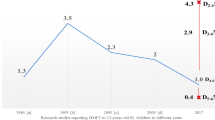Abstract
Design A case-control randomised trial.
Case/control selection Preschools in Tehran/Iran were selected for inclusion through multi-stage cluster random sampling. They were divided into strata based on population density and a preschool from each was randomly selected. From this, children aged 4-6 years were identified. Twelve children from each preschool were placed into the 'caries-free' experimental group and 12 into the 'caries present' control group. Where insufficient experimental group participants were recruited, additional control group participants were included. Incentives for participation included free preventive procedures and completion of required dental treatment. All participants underwent intraoral examinations and independent parent questionnaires. The study received ethical approval.
Data analysis Participants were assessed objectively for caries status by blinded calibrated examiners, using a standardised and validated questionnaire as part of a face-to-face interview. This questionnaire included three domains: sociodemographic factors, behavioural oral health measures and feeding practices/dietary habits. Sociodemographic characteristic recorded included sex, age, the number of siblings and the parents' level of education. A logistic regression model was applied to identify caries-free protective factors (p <0.05). The collected data was then entered into the SPSS software version 21 for statistical analysis.
Results In total, 528 participants were recruited, with 28 ineligible due to lack of consent. This resulted in 230 participants in the experimental group and 270 in the control group. Protective factors against dental caries were identified as: dental check-up as the cause of dental visit; being the eldest child in the family; minimised night feeding; family owning their residence; and parents having university-level education (p <0.05). Antibiotic consumption and mothers who were not able to make their children brush their teeth were not identified as factors.
Conclusions The outcome showed that protective factors including regular check-up and socioeconomic factors are associated with dental health. Dental check-up as the cause of dental visit, being the eldest child in the family, minimised night feeding, family owning their residence and parents having university-level education reduce the chance of preschool children suffering dental caries.
This is a preview of subscription content, access via your institution
Access options
Subscribe to this journal
Receive 4 print issues and online access
$259.00 per year
only $64.75 per issue
Buy this article
- Purchase on Springer Link
- Instant access to full article PDF
Prices may be subject to local taxes which are calculated during checkout
Similar content being viewed by others
References
Petersen P E. The World Oral Health Report 2003: continuous improvement of oral health in the 21st Century - the approach of the WHO Global Oral Health Programme. Community Dent Oral Epidemiol 2003; 31 Suppl 1: 3-23.
Casamassimo P S, Thikkurissy S, Edelstein B L, Maiorini E. Beyond the dmft: the human and economic cost of early childhood caries. J Am Dent Assoc 2009; 140: 650-657.
Jessor R, Turbin M S, Costa F M. Risk and protection in successful outcomes among disadvantaged adolescents. Appl Develop Sci 1998; 2: 194-208.
Anil S, Anand P S. Early Childhood Caries: Prevalence, Risk Factors, and Prevention. Front Paediatr 2017; 5: 157.
Author information
Authors and Affiliations
Rights and permissions
About this article
Cite this article
Hutchison, C. Can protective factors prevent caries in preschool children?. Evid Based Dent 22, 114–115 (2021). https://doi.org/10.1038/s41432-021-0192-0
Published:
Issue Date:
DOI: https://doi.org/10.1038/s41432-021-0192-0



